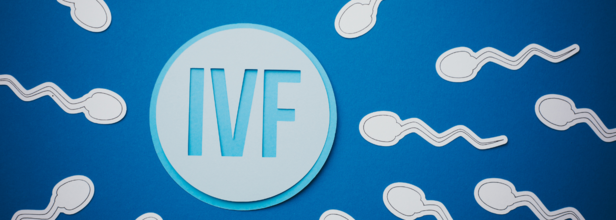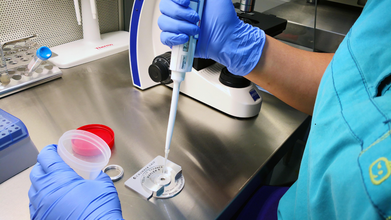- Health Conditions A-Z
- Health & Wellness
- Nutrition
- Fitness
- Health News
- Ayurveda
- Videos
- Medicine A-Z
- Parenting
- Web Stories
IVF Day 2025: What Happens To The Unused Embryo After An Unsuccessful IVF?

Credits: Canva
Every year, July 25 is celebrated as IVF Day, marking the birth of the world’s first IVF baby, Louise Brown, in 1978. More than four decades later, IVF is no longer just a medical breakthrough—it’s a deeply emotional journey that thousands of couples undertake in the hope of starting a family. But as Dr. Firuza Parikh, Director at Jaslok-FeetilTree International Fertility Centre, reminds us, IVF is “not just science—it’s intensely human.”
When IVF Doesn’t End in a Cradle
Despite being a beacon of hope, IVF doesn’t always result in a child. “There’s a kind of heartbreaking silence that follows a failed IVF cycle,” Dr. Parikh shares. “The couple walks in full of cautious optimism, but sometimes they leave facing a reality they weren’t prepared for.”
She adds that a failed cycle can feel like grief. “I’ve had women sit across from me feeling betrayed by their own bodies, wondering if they didn’t try hard enough. To them, I always say: ‘This is not your fault.’”
More Than Just the Woman's Journey
While women often bear the brunt of IVF physically and emotionally, Dr. Parikh insists we look at the whole picture. “The embryo is not just hers—it’s theirs. Men need to be involved too. We evaluate sperm quality, suggest lifestyle changes, and support them emotionally as well.”
She emphasizes male fertility is just as important: “Age, stress, smoking, and even heat exposure can affect sperm quality.”
Pausing Is Not Giving Up
IVF cycles can be taxing—not just on the body but the spirit. “Sometimes, it’s the soul that says ‘I’m tired’ even when the body soldiers on,” says Dr. Parikh. “In those moments, I gently ask: Do you want to pause? Not stop—just pause and breathe.”
She adds that readiness for IVF goes beyond hormone levels or test results. “Is she sleeping well? Is she emotionally steady? IVF is not a race. It helps to slow down and give the body and mind a moment to catch up.”
The Embryos Left Behind
One of the most delicate parts of IVF is deciding what to do with unused embryos. “Sometimes they’re frozen, sometimes they remain untouched after a successful cycle,” says Dr. Parikh. “Years later, women call and ask what to do. Letting go of these embryos is like saying goodbye to a version of the future that could have been.”
She adds, “Those embryos are not just cells—they’re possibilities.”
Motherhood Isn’t the Only Definition of Womanhood
Not every woman who chooses IVF becomes a mother, and that’s okay. “IVF isn’t a test of womanhood,” Dr. Parikh insists. “Sometimes success is a baby, sometimes it’s the courage to try, and sometimes, it’s the grace to walk away.”
Every woman who undergoes IVF deserves to be honored—regardless of the outcome—for her strength, her vulnerability, and her resilience.
Healing Through Mindfulness
After an emotionally exhausting cycle, Dr. Parikh gently introduces the idea of mindfulness. “It’s not about fixing. It’s about feeling,” she says. “It creates a small, sacred space where healing quietly begins.”
As we mark IVF Day, Dr. Parikh’s words serve as a powerful reminder: “You are not defined by what didn’t happen. You are never without hope. Because sometimes, what lies beyond the embryo… is you.”
Delhi Air Pollution Now Impacting Babies' Respiratory System As They Spend More Time In The Nursery, According To Doctor

Credits: Canva
Since October 19, the PM2.5 levels, which is one of the key pollutants, in Delhi has hovered well above 120 micrograms, while even crossing 200 a couple of times. While the World Health Organization (WHO) guidelines recommend the average PM2.5 levels to be at 15 micrograms per day, reported Healthy Policy Watch. In June 2023, when New York hit PM2.5 levels of 117 micrograms, advisories were issued to shut down schools, for people to remain indoors, and to wear masks. However, there have been no such advisory in Delhi so far.
The data on Delhi pollution has been unreliable, several media outlets have reported the discrepancy between the official data and the on ground data. Many videos online have also shown the gap between these data where people are using their private AQI machines to measure the air quality. Furthermore, a video from opposition legislator Saurabh Bharadwaj that showed water being sprinkled around a government-run air monitoring station in the city on Diwali night have also raised questions on whether the data was tampered.
Amid all this, while doctors have time and again have asked everyone to stay safe, wear mask, and avoid going out during peak hours, studies too have shown fatal links with worsening air pollution. Now, there is an increased risk for infants too. Dr Anjana Singh, director and head of Obstetrics and Gynaecology at Fortis, Noida, as told to the Indian Express said, "Nowadays each newborn is spending a longer time in the nursery before they can be discharged because they are born with respiratory problems and their lung function needs to be stabilised. Some of them have delayed lung development and congenital asthma later. More and more babies are being born with jaundice."
Pollution And Infant Health
The doctor points out that pollution has a deep impact on fetal development than one may think. "It is the reason why we are seeing many more cases of miscarriage, pre-term births, stillbirths, birth defects, congenital heart disease and neural tube defects (the brain and spine do not develop properly)," the doctor explains.
Toxic particles can cross the placenta, the temporary organ that links a baby to the mother through the umbilical cord, and disrupt normal development. They trigger inflammation in the placenta, which creates resistance to blood flow. Over time, the blood vessels become damaged, reducing the amount of blood reaching the fetus.
Air pollution can mess with how nutrients reach the baby, which often leads to low birth weight. Research also shows that when a pregnant woman is exposed to polluted air, the risk of stillbirth goes up, especially in the third trimester.
High levels of fine particulate matter (PM2.5) are linked to low birth weight and premature birth, both of which can cause other health problems. Tiny sooty particles can move through the mother’s bloodstream to the placenta and affect the baby’s lung development, raising the risk of lifelong breathing issues like asthma.
Pollutants such as nitrogen dioxide and PAHs which come from things like burning food, coal, oil or gas can disrupt how organs form. This can increase the chances of conditions like congenital heart defects, neural tube problems or cleft palate. Some studies also suggest that heavy exposure to air pollution during pregnancy may raise the risk of autism spectrum disorder.
Air pollution can also push the mother’s blood pressure up, increasing the risk of preeclampsia, which is dangerous for both mom and baby.
Microplastics in the air come from synthetic clothes, car tires and broken down plastic waste. They act as endocrine disruptors, meaning they can interfere with hormones during key stages of development. They’ve been linked to gestational diabetes, inflammation and gut microbiome imbalance. Microplastics have even been found in the placenta, umbilical cord and cord blood, showing they can reach the baby and interfere with organ and nervous system development.
Children Aren't Distracted By Nature, It's In Their Biology: Research Shows Why Their Attention Span Is Less

(Credit-Canva)
Children are known for hopping from one activity to the next, often when they should be focusing on just one thing. This is a common experience for parents and teachers. A new study suggests that this behavior is not just because kids are naturally curious. Instead, the real reason has a lot to do with the way their younger brains are still growing and working.
Children have a characteristic less attention span, and many people believe that it is simply because the children don’t find it interesting enough, however the study proved that this is not true. Published in the Journal of Experimental Psychology: General, researchers discovered that children's ability to stay focused on one task is limited because their working memory is not yet fully developed.
Why Do Children Have Less Attention Span?
Working memory is like the brain’s temporary notepad, it holds information needed to complete a task. When this memory gets overloaded, children can't stay "locked in" on a single job.
Researchers at Ohio State University essentially forced adults to behave like young kids during a task. They found that when an adult's working memory was filled up, their attention scattered, and they started acting just like young children.
To create the "kid-like" condition, some of the adults were asked to do a second, very difficult task at the same time as playing the candy game. This second task required them to intensely focus on a screen full of numbers and immediately shout out whenever they saw two odd numbers appear right after each other.
This extra mental effort, or load, completely soaked up their working memory, making it much harder for them to stay focused on finding the best candy character.
How Do People Concentrate?
The study included 40 five-year-olds and 71 adults who played a computer game. In the game, participants collected virtual candy from four cartoon characters. Each character always gave a different, fixed amount of candy (1, 2, 3, or 10). The goal was to figure out which character gave the biggest reward.
Some of the adults were given a second, demanding task to do at the same time: they had to watch numbers streaming by and call out when two odd numbers appeared in a row. This extra mental load made it much harder for them to focus on the candy game.
What Causes Scattered Attention In Kids?
Everyone, including the children and the distracted adults, was able to figure out which character gave the largest candy reward. However, the adults whose memory was overloaded, just like the young children, kept switching between characters instead of sticking to the best choice.
Researchers explained noted that this scattered attention happened even when participants knew the correct answer. The finding suggests that what we see as simple distraction in kids might actually come from a brain that is still developing.
The results change how we should view a child's attention span. They suggest that a child's natural tendency to switch focus might actually be a good thing, helping them learn in ways that are more flexible and adaptable than adults. It's not a weakness. This vital research could help teachers and parents create new teaching methods that work with a young child's natural way of learning, instead of always trying to make them concentrate against their developing brain's natural tendencies.
Fact Check: Semen Production Means You Have Healthy Sperms, Here's What The Doctor Says

Credits: Canva
Men's health is a topic often not talked about, however, it is as important as any other health related topics that are addressed more frequently. This is the case especially when it comes to men's reproductive health. While there has a been a lot of studies around semen production and what makes a sperm healthy, there are still many myths around it.
To burst one of such myths, we spoke to Dr Beena Muktesh, Senior IVF Expert at Motherhood Hospital, Gurugram. We asked her whether there was any truth in the claim that semen production is linked to healthy sperm.
Dr Muktesh points out that while sperm-related problems are rampant in men, many men still assume that producing semen automatically indicates fertility. "However, it is a myth that needs to be addressed." She says that there is a need to understand the difference between the two.
What Is Semen? How Does It Tell Whether The Sperm Is Healthy?
Semen is a fluid that is released during ejaculation. It contains sperm and other substances from the male reproductive organs. The sperm is around 1 to 5% of the semen. The rest of it is a liquid called seminal plasma, this includes water, proteins, enzymes, and nutrients like fructose for energy. It Is important for reproduction by helping sperm reach and fertilize the egg. "Healthy semen is pivotal when it comes to male fertility. However, a common myth among men is that if they ejaculate normally, their sperm must be healthy and fertile," she points out.
The doctor says that while semen production is sign that the reproductive system is functioning, it may not guarantee that the sperm it contains are capable of fertilizing an eff.
Dr Muktesh says, "Fertility depends not just on the presence of sperm but on their count, motility or movement, and morphology, or shape. Though many women do not know about this fact and continue to struggle in silence."
Semen that appears normal is volume, color and consistency, could still contain sperm that are low in number. They could move poorly, or have structural abnormalities, pointed out the doctor. "These factors impact the ability of sperm to reach and fertilize an egg, making conception difficult even if ejaculation occurs regularly."
The doctor suggests that men must undergo a semen analysis to evaluate their fertility. The analysis will be able to tell the number of sperm in a given volume of semen.
"Low count can reduce the chances of fertilization. The sperm motility will be checked to know how the sperm will move. Poor motility means sperm may struggle to reach the egg. The expert will also pay attention to the sperm shape and structure. Abnormal shapes can affect the ability to penetrate and fertilize the egg, and make conception challenging," she points out.
There are also other factors like the semen pH, volume, and white blood cell presence that could be monitored to detect infections or other underlying concerns. This is why it is important to get the analysis done and not just assume, she points out.
"Awareness and early evaluation allow timely intervention, increasing the chances of conception and promoting informed decisions about reproductive health. So, men, consult the expert without any delay and know about your sperm health status for healthy conception," she says.
© 2024 Bennett, Coleman & Company Limited

